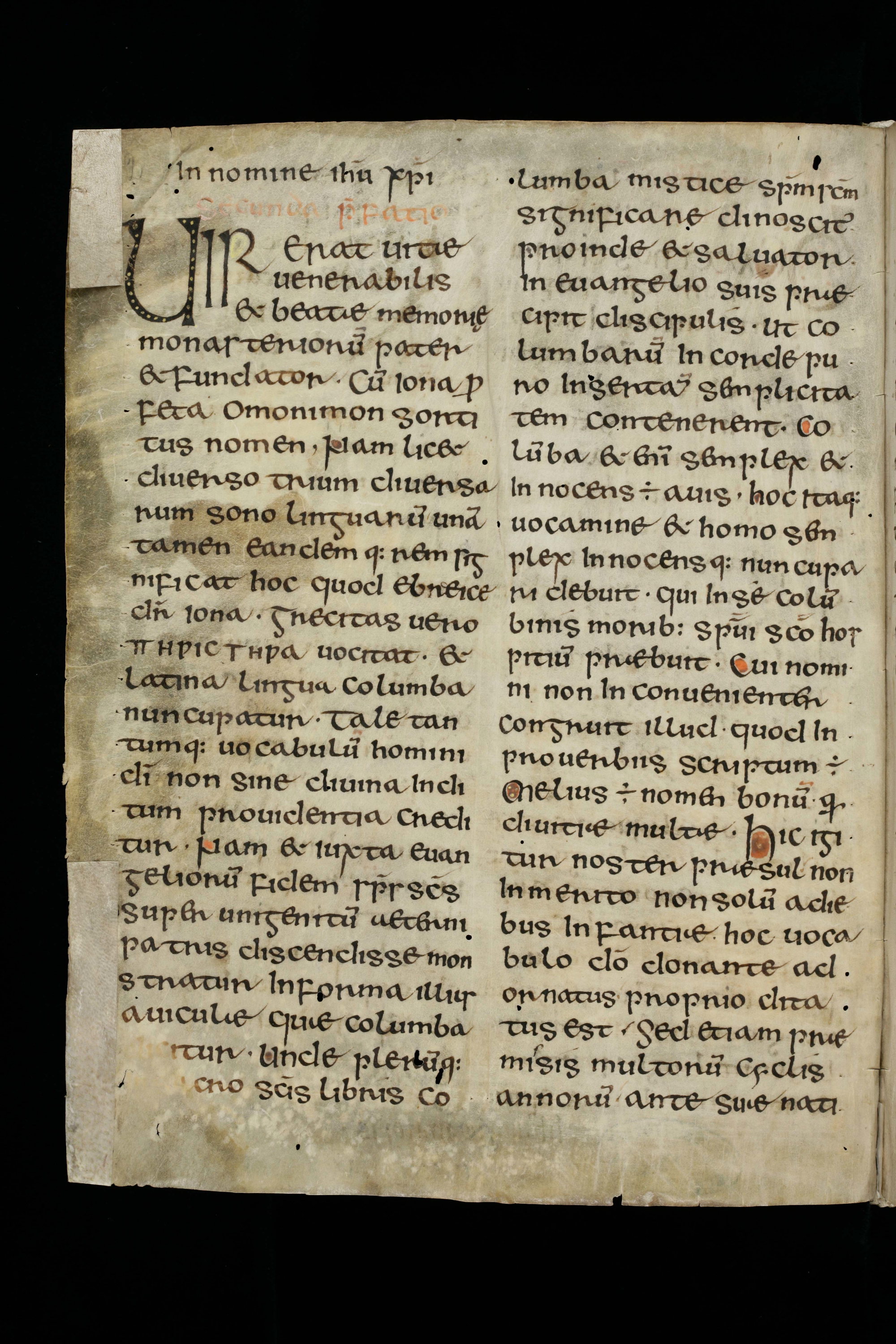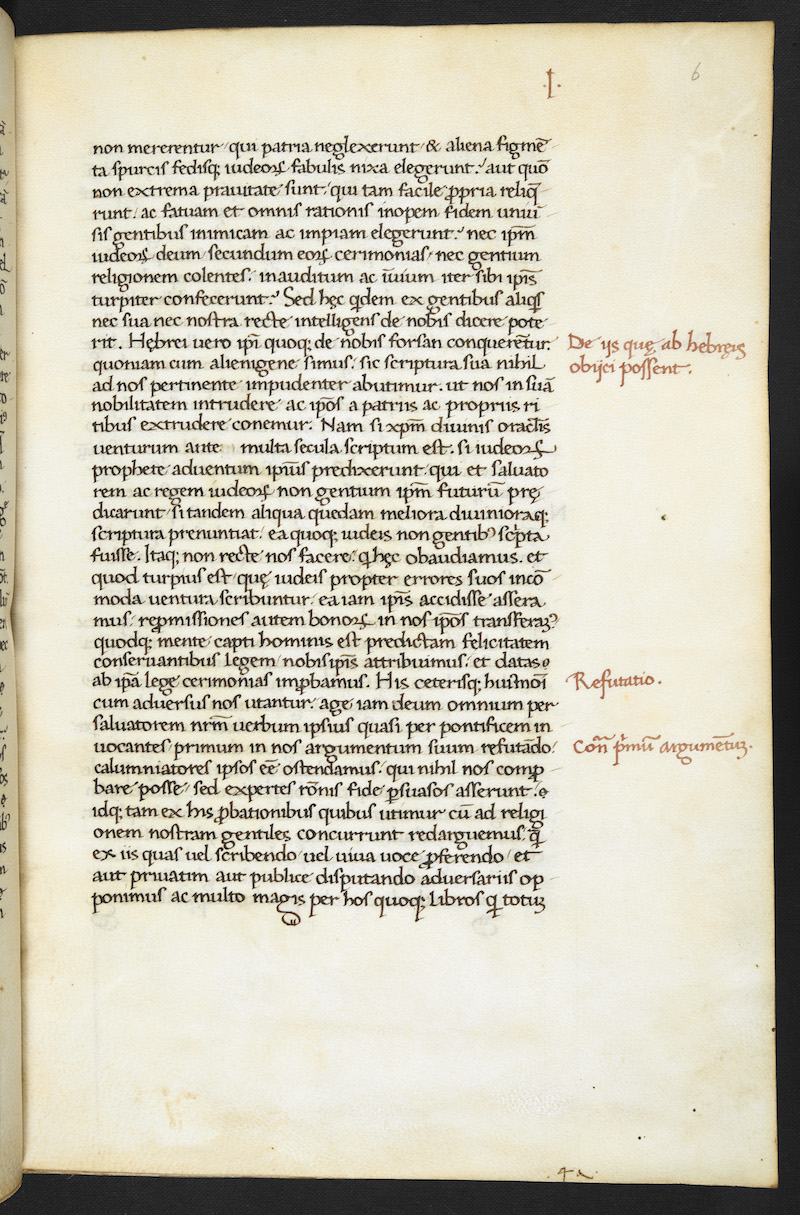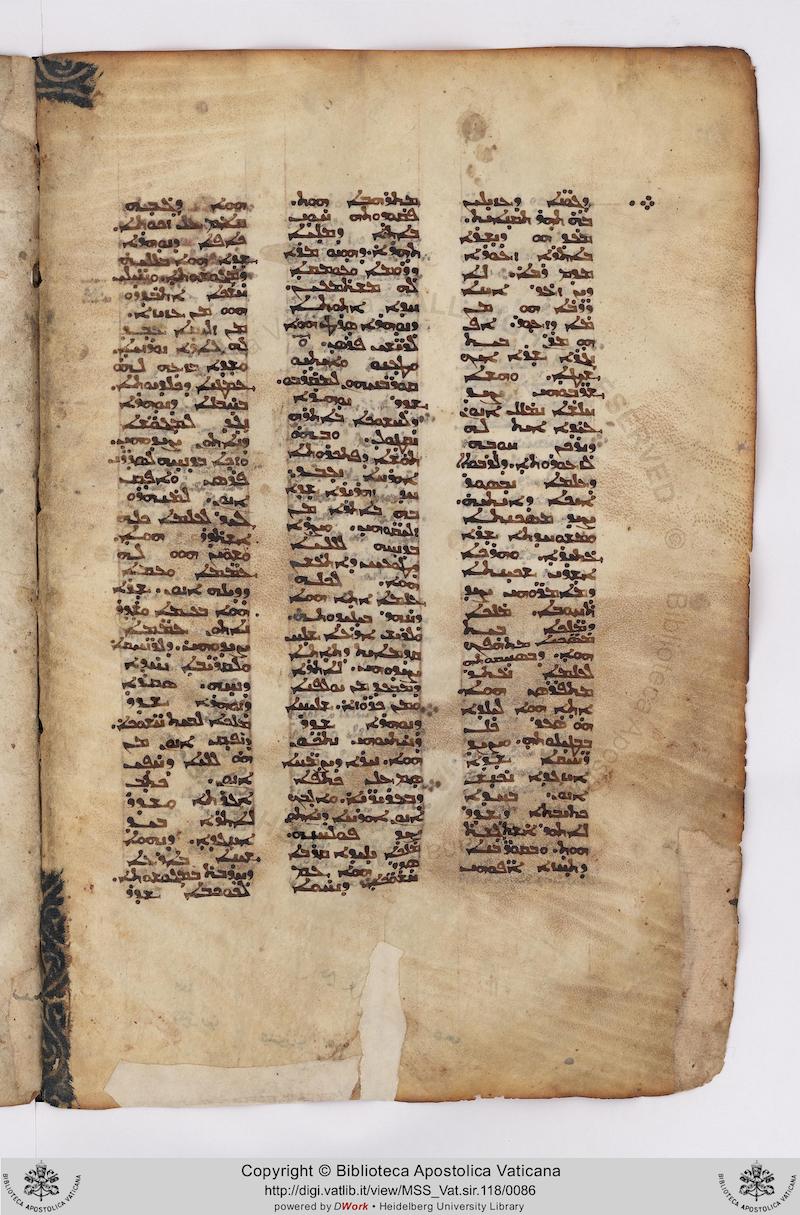
Insular Minuscule, 7th-8th century
-
Title
Adomnan, Life of St. Columba -
Text
Secunda preafatio (second preface) -
Language(s)
Latin -
Writing System
Roman -
Script(s)
Insular Minuscule -
Country
Switzerland -
City
Schaffhausen -
Repository
Stadtsbibliothek -
Shelf Mark
Gen. 1, page 2 -
Common Name
The Schaffhausen Adomnan -
Century
7th-8th century -
Year Range
688-713 -
Place Of Origin
Scotland, Iona -
Provenance
In Northern France by the middle of the 9th century; in St. Gall during the latter half of the 10th century; in Reichenau by the 13th century. In Schaffhausen by 1772 -
Bibliography
Rudolf Gamper and Susan Marti, Katalog der mittelalterlichen Handschriften der Stadtbibliothek Schaffhausen (1998), 67-68.
-
External Facsimile
This is the earliest manuscript of the Life of St. Columba by Adamnan (Adomnan). According to a notice on p. 6, the scribe was one Dorbbéne, who is presumed to be the man who became abbot of Iona for five months before his death in 713.
Iona, which is in modern Scotland, was a center of Irish monasticism from its founding by Columba in the 6th century. The script of this copy of the Life of Columba shows features common to early medieval scripts of both Ireland and England – a class of scripts known collectively as "Insular" – as well as features of layout that are particularly associated with Irish scriptoria. The distinctively Irish feature illustrated by this page is the Irish diminuendo – the technique of marking new sections of the text with large letters that gradually shrink over the course of a line until the letters are the size of the main script of the text.
Distinctively Insular forms that appear on this page include:
- f with the lower crossbar sitting right on the baseline
- the distinctive Insular g, which resembles a long, open s-curve with a crossbar at minim height
- the r whose right stroke curves all the way down to the baseline, so that it looks almost like an n. (In some cases, the left leg of r descends so far that the letter can be mistaken for a p.)
- an s that looks more like a modern lower-case r – note that the s's shoulder does not bend down toward the baseline. This is an Insular version of the s used in Half-Uncial. This scribe uses both that Insular s and the round, Uncial s.
- The Insular ÷ abbreviation for est.
This scribe also uses a tall e whose tongue reaches out to join up with the first stroke of the following letter. This is not a particularly Insular feature, but is common to many early medieval scripts. The a-e ligature (æ), which is used in alternation with ae and with ȩ, looks like an e with half a u attached on the left.
The letterforms are otherwise basically those of Half-Uncial, which is the ancestor of Insular minuscule.
Although the ruling is hard to see here, the prickings made to guide the ruling are clearly visible in the outer margins of the page. This manuscript illustrates the Insular practice of pricking the quire after folding – that is, pricking both the inner and outer margin of each page. (By contrast, the normal Continental practice was to prick the parchment with the quire folded open, so that prickings appear only in the outer margin of each page.)
Acknowledgements: Described by Carin Ruff
Transcription
Column 1
1 In nomine ie(s)u chr(ist)i
2 secunda p(rae)fatio
3 VIR Erat uitæ
4 uenerabilis
5 et beatæ memoriȩ
6 monasterioru(m) pater
7 et fundator∙ Cu(m) iona p(ro)(-)
8 feta omonimon sorti(-)
9 tus nomen, Nam licet
10 diuerso trium diuersa(-)
11 rum sono linguaru(m) una(m)
12 tamen eandemq(ue) rem sig(-)
13 nificat hoc quod ebreice
14 d(icitu)r iona. grecitas uero
15 ΠΗΡΙΣΤΗΡΑ uocitat. et
16 latina lingua columba
17 nuncupatur∙ Tale tan(-)
18 tumq(ue) uocabulu(m) homini
19 d(e)i non sine diuina indi(-)
20 tum prouidentia credi(-)
21 tur∙ Nam et iuxta euan(-)
22 gelioru(m) fidem sp(iritu)s s(an)c(tu)s
23 super unigenitu(m) aeterni
24 patris discendisse mon(-)
25 stratur in forma illius
26 auiculæ quæ columba
27 dicitur∙ Unde pleru(m)q(ue)
28 [[****]]cro s(an)c(ti)s libris co(-)
Column 2
1 lumba mistice sp(iritu)m s(an)c(tu)m
2 significare dinoscit(ur)
3 proinde et saluator
4 in euangelio suis præ(-)
5 cipit discipulis∙ ut co(-)
6 lumbaru(m) in corde pu(-)
7 ro inserta(m) semplicita(-)
8 tem contenerent∙ Co(-)
9 lumba eteni(m) semplex et
10 innocens (est) auis∙ hoc itaq(ue)
11 uocamine et homo sem(-)
12 plex innocensq(ue) nuncupa(-)
13 ri debuit∙ qui in se colu(m)
14 binis morib(us) sp(irit)ui s(an)c(t)o hos(-)
15 pitiu(m) præbuit∙ Cui nomi(-)
16 no non inconuenienter
17 congruit illud∙ quod in
18 prouerbiis scriptum (est)
19 Melius (est) nomen bonu(m) q(uam)
20 diuitiæ multæ∙ Hic igi(-)
21 tur noster præsul non
22 inmerito non solu(m) a die(-)
23 bus infantiæ hoc uoca(-)
24 bulo d(e)o donante ad(-)
25 ornatus proprio dita(-)
26 tus est ´ Sed etiam præ(-)
27 mi\s/sis multoru(m) cyclis
28 annoru(m) ante suæ nati(-)
Paleographic Features
1. "Irish diminuendo" is used in col. 1, line 3 to mark the beginning of the text proper. The size of the letters decreases from the large V into the second word.
2. Insular r, with second stroke bending down to the baseline, is seen in erat, col. 1, line 3, and uenerabilis, col. 1, line 4. Note that the first stroke may or may not descend appreciably below the baseline.
3. Tall e with tongue reaching out to join the following letter is seen in memoriȩ at the end of col. 1, line 5, and pater at the end of col. 1, line 6.
4. The fifth letter in col. 1, line 6 is Insular s, with a shoulder at minim-height that does not bend down towards baseline. Contrast this with r later in this word, monasterioru(m).
5. Insular f with long hasta at the baseline appears at the beginning of col. 1, line 8.
6. Insular g appears in linguaru(m) in col. 1, line 11.
7. The syllable at the end of col. 1, line 12 is sig. Note the Insular forms of s and g.
8. Col. 1, line 15 begins with the Greek word ΠΗΡΙΣΤΗΡΑ (peristera), "dove" – the Greek interpretation of Columba's name
9. Seven lines from the bottom of the left column, at the end of the line, the nomina sacra abbreviations for spiritus and sanctus show the two forms of s: Insular or Half-Uncial s in spiritus and round or Uncial s in sanctus.
10. Five lines from the bottom of col. 1, the second word in the line is discendisse. Note that the d is easily mistaken for cl. Compare the l in columba at the end of the line three lines from the bottom of col. 1. The l curves at the bottom.
11. This is æ (the a-e ligature). If you compare ae written as separate letters in this hand (#14), you can see how when the two forms are combined they come to look like this.
12. Four lines from the bottom of col. 1, the last word in the line is illius, with a u-s ligature. Note once again the form of long s in this script.



